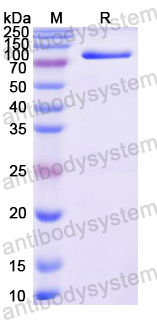Catalog No.
YMG34201
Expression system
E. coli
Species
Mus musculus (Mouse)
Protein length
Ser61-His706
Predicted molecular weight
76.07 kDa
Nature
Recombinant
Endotoxin level
Please contact with the lab for this information.
Purity
>90% as determined by SDS-PAGE.
Accession
Q9CQN1
Applications
ELISA, Immunogen, SDS-PAGE, WB, Bioactivity testing in progress
Form
Lyophilized
Storage buffer
Lyophilized from a solution in PBS pH 7.4, 0.02% NLS, 1mM EDTA, 4% Trehalose, 1% Mannitol.
Reconstitution
Reconstitute in sterile water for a stock solution. A copy of datasheet will be provided with the products, please refer to it for details.
Shipping
In general, proteins are provided as lyophilized powder/frozen liquid. They are shipped out with dry ice/blue ice unless customers require otherwise.
Stability and Storage
Use a manual defrost freezer and avoid repeated freeze thaw cycles. Store at 2 to 8°C for frequent use. Store at -20 to -80°C for twelve months from the date of receipt.
Alternative Names
Heat shock protein 75 kDa, mitochondrial, HSP 75, TNFR-associated protein 1, Tumor necrosis factor type 1 receptor-associated protein, TRAP-1, Trap1, Hsp75, Hspc5
New biomarkers of Kawasaki disease identified by gingival crevicular fluid proteomics., PMID:40421421
Molecular interactions of Toxoplasma gondii dense granule 23 (GRA23) with host proteins PEX3 and TRAP1., PMID:40417354
Mitochondrial HSP90 paralog TRAP1 deletion drives glutamine addiction in tumor cells via destablization of the Cys/Glu antiporter SLC7A11/xCT., PMID:40378155
An orally administered gene editing nanoparticle boosts chemo-immunotherapy in colorectal cancer., PMID:40269250
Ochratoxin A-induced mitochondrial pathway apoptosis and ferroptosis by promoting glycolysis., PMID:40167953
Targeting TRAP1-dependent metabolic reprogramming to overcome doxorubicin resistance in quiescent breast cancer., PMID:40086176
Point mutations of the mitochondrial chaperone TRAP1 affect its functions and pro-neoplastic activity., PMID:40074754
Management succinate release through SDHA by G protein-coupled receptor 91 signal, TRAP1, and SIRT3 regulation in lung cancer cells by NAR nanoparticles., PMID:40074439
The HOPS and vCLAMP protein Vam6 connects polyphosphate with mitochondrial function and oxidative stress resistance in Cryptococcus neoformans., PMID:39998208
Fast Degradation of MecciRNAs by SUPV3L1/ELAC2 Provides a Novel Opportunity to Tackle Heart Failure With Exogenous MecciRNA., PMID:39973625
Tumor necrosis factor receptor-associated protein 1 promotes aerobic glycolysis and cisplatin resistance by regulating the Wnt/β-catenin signaling pathway in lung cancer., PMID:39679449
Development of a Fluorescence Probe for High-Throughput Screening of Allosteric Inhibitors Targeting TRAP1., PMID:39568139
Activating p53Y220C with a Mutant-Specific Small Molecule., PMID:39554093
The role of TRAP1 in regulating mitochondrial dynamics during acute hypoxia-induced brain injury., PMID:39468583
Mutation in the mitochondrial chaperone TRAP1 leads to autism with more severe symptoms in males., PMID:39333440
The METTL3/TRAP1 axis as a key regulator of 5-fluorouracil chemosensitivity in colorectal cancer., PMID:39287889
Mitochondrial chaperon TNF-receptor- associated protein 1 as a novel apoptotic regulator conferring susceptibility to Pneumocystis jirovecii pneumonia., PMID:39224595
TRAP1 modulates mitochondrial biogenesis via PGC-1α/TFAM signalling pathway in colorectal cancer cells., PMID:39210159
HSP90 multi-functionality in cancer., PMID:39148727
TRAP1 drives smooth muscle cell senescence and promotes atherosclerosis via HDAC3-primed histone H4 lysine 12 lactylation., PMID:39088352
Novel energy optimizer, meldonium, rapidly restores acute hypobaric hypoxia-induced brain injury by targeting phosphoglycerate kinase 1., PMID:39075489
Glutamine deprivation in glioblastoma stem cells triggers autophagic SIRT3 degradation to epigenetically restrict CD133 expression and stemness., PMID:39068621
Multi-omics profiling reveal cells with novel oncogenic cluster, TRAP1low/CAMSAP3low, emerge more aggressive behavior and poor-prognosis in early-stage endometrial cancer., PMID:38880903
Anti-inflammatory activities of novel heat shock protein 90 isoform selective inhibitors in BV-2 microglial cells., PMID:38756532
The Role of HSP90 and TRAP1 Targets on Treatment in Hepatocellular Carcinoma., PMID:38684604
The development of cancers research based on mitochondrial heat shock protein 90., PMID:38098505
Targeting the Mitochondrial Chaperone TRAP1 Alleviates Vascular Pathologies in Ischemic Retinopathy., PMID:37983591
Mechanism of Nrf2/miR338-3p/TRAP-1 pathway involved in hyperactivation of synovial fibroblasts in patients with osteoarthritis., PMID:37920489
Inhibition of TRAP1 Accelerates the DNA Damage Response, Activation of the Heat Shock Response and Metabolic Reprogramming in Colon Cancer Cells., PMID:37796715
TRAP1 inhibits MARCH5-mediated MIC60 degradation to alleviate mitochondrial dysfunction and apoptosis of cardiomyocytes under diabetic conditions., PMID:37679468
IFI27 Integrates Succinate and Fatty Acid Oxidation to Promote Adipocyte Thermogenic Adaption., PMID:37544897
Multiple Targeting of HSP Isoforms to Challenge Isoform Specificity and Compensatory Expression., PMID:37540433
Detecting Posttranslational Modifications of Hsp90 Isoforms., PMID:37540432
Gene Expression and Drug Sensitivity Analysis of Mitochondrial Chaperones Reveals That HSPD1 and TRAP1 Expression Correlates with Sensitivity to Inhibitors of DNA Replication and Mitosis., PMID:37508418
Impact of climate factors and climate-gene interaction on systemic lupus erythematosus patients' response to glucocorticoids therapy., PMID:37488812
Cytosolic and mitochondrial translation elongation are coordinated through the molecular chaperone TRAP1 for the synthesis and import of mitochondrial proteins., PMID:37487647
Identification of mitochondrial related signature associated with immune microenvironment in Alzheimer's disease., PMID:37434203
CVM-1118 (foslinanib), a 2-phenyl-4-quinolone derivative, promotes apoptosis and inhibits vasculogenic mimicry via targeting TRAP1., PMID:37351538
Elucidation of novel TRAP1-Selective inhibitors that regulate mitochondrial processes., PMID:37307624
Prognostic modelling of colorectal cancer based on oxidative stress-related genes., PMID:37300722
The Epithelial to Mesenchymal Transition in Colorectal Cancer Progression: The Emerging Role of Succinate Dehydrogenase Alterations and Succinate Accumulation., PMID:37239099
Corrigendum: HSP70 and HSP90 in cancer: cytosolic, endoplasmic reticulum and mitochondrial chaperones of tumorigenesis., PMID:37207142
Salivary proteins offer insights into keratinocyte death during aphthous stomatitis. A case-crossover study., PMID:37170213
Analysis and functional relevance of the chaperone TRAP-1 interactome in the metabolic regulation and mitochondrial integrity of cancer cells., PMID:37165028
Genome-wide identification of alternative splicing and splicing regulated in immune infiltration in osteosarcoma patients., PMID:37139238
TRAP1 S-nitrosylation as a model of population-shift mechanism to study the effects of nitric oxide on redox-sensitive oncoproteins., PMID:37085483
Histone chaperone SSRP1 is required for apoptosis inhibition and mitochondrial function in HCC via transcriptional promotion of TRAP1., PMID:37084412
Following the design path of isoform-selective Hsp90 inhibitors: Small differences, great opportunities., PMID:37001734
TRAP1 Is Expressed in Human Retinal Pigment Epithelial Cells and Is Required to Maintain their Energetic Status., PMID:36829938
The mitochondrial chaperone TRAP-1 regulates the glutamine metabolism in tumor cells., PMID:36828164

